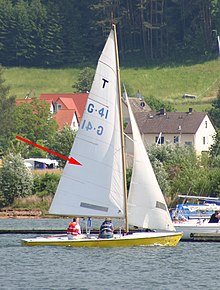Mainsail

As a mainsail (or shortly only bulk ) that is sailing denotes that the main mast of a sailing ship or on the mast of a slupgetakelten sailing boat or a sailing boat is driven.
description
Depending on the type of ship, the mainsail can be a sloping sail or a square sail . On frame-rigged ships , it is the lowest sail on the main mast. With yachts it is the sloping sail on the single mast or with yawl or ketch-rigged ships the one on the front, larger mast. Yachts with a foremast , in which the front mast is smaller than the rear, are very rare.
Contrary to the name, the mainsail does not have to be the largest sail on board. The area of a genoa can exceed that of the mainsail, which, however, requires very tight sheet angles and therefore tightly fitting shrouds , a design feature that was more common on ships of the 1970s and 1980s. A spinnaker or gennaker is also significantly larger than the mainsail. The mainsail usually has the most extensive equipment of all sails on board , as it remains set in almost all weather and wind situations and has to be adapted to these conditions.
The mainsail can be designed as a high sail - the predominant form today - or as a gaff sail . The try sail is used instead of the main sail in a heavy storm. The foot of the sail can be firmly attached to the main boom or it can remain open so that the sail is only connected to the boom at the clew. The sail position is adjusted with the mainsheet .
Designs
Two designs are common today for the mainsail:
- Battened size
The traditional variant is the slatted main with a binder . Here, the salvaged sail lying on the tree and in the harbor there aufgetucht , d. H. tied up. To set, the head is pulled up on the mast. If the entire sail area is not required, the lower part remains tied to the tree. This variant is the norm, especially for small boats. By incorporating so-called battens horizontally into the sail, it is possible to improve the aerodynamic profile . In addition, this enables the sail to be cut a little larger than the mainsail triangle would actually dictate, because the battens support the leech. If the battens extend along the entire length of the sail, one speaks of a battened sail .
- Furling main
The sail is rolled into the mast when recovering. This furling system for the large is supposed to simplify the operation, but it harbors some dangers in case of improper use. In addition, due to the design, the sail cannot be battened - except vertically, which is much less effective. The sail can be set in any size for this. Mainsails rolled around or in the tree are practically no longer found.
See also: List of sail types

literature
- Joachim Schult: Sailors Lexicon. 9th edition. Delius Klasing, Bielefeld 1994, ISBN 3-87412-103-8 . Keyword mainsail
- Seamanship. Yachting manual. 30th edition, Delius Klasing Verlag , Bielefeld 2013, ISBN 978-3-7688-3248-9 .
